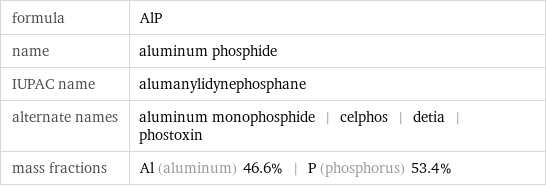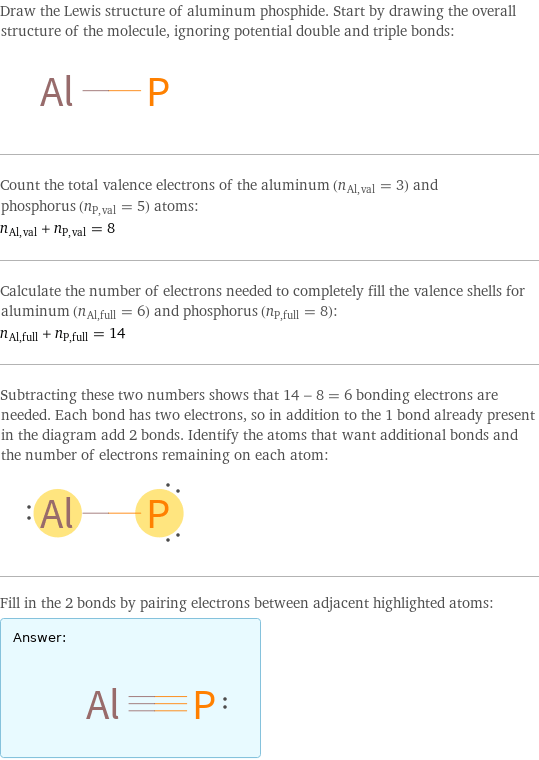Input interpretation

aluminum phosphide
Chemical names and formulas

formula | AlP name | aluminum phosphide IUPAC name | alumanylidynephosphane alternate names | aluminum monophosphide | celphos | detia | phostoxin mass fractions | Al (aluminum) 46.6% | P (phosphorus) 53.4%
Lewis structure

Draw the Lewis structure of aluminum phosphide. Start by drawing the overall structure of the molecule, ignoring potential double and triple bonds: Count the total valence electrons of the aluminum (n_Al, val = 3) and phosphorus (n_P, val = 5) atoms: n_Al, val + n_P, val = 8 Calculate the number of electrons needed to completely fill the valence shells for aluminum (n_Al, full = 6) and phosphorus (n_P, full = 8): n_Al, full + n_P, full = 14 Subtracting these two numbers shows that 14 - 8 = 6 bonding electrons are needed. Each bond has two electrons, so in addition to the 1 bond already present in the diagram add 2 bonds. Identify the atoms that want additional bonds and the number of electrons remaining on each atom: Fill in the 2 bonds by pairing electrons between adjacent highlighted atoms: Answer: | |
Basic properties

molar mass | 57.9553005 g/mol phase | solid (at STP) melting point | 2530 °C density | 2.85 g/cm^3 solubility in water | reacts
Units

Solid properties (at STP)

density | 2.85 g/cm^3
Units

Thermodynamic properties

specific heat of formation Δ_fH° | solid | -2.873 kJ/g molar heat of formation Δ_fH° | solid | -166.5 kJ/mol (at STP)
Chemical identifiers
![CAS number | 20859-73-8 PubChem CID number | 30332 SMILES identifier | [Al]#P InChI identifier | InChI=1/Al.P/rAlP/c1-2 EU number | 244-088-0 Gmelin number | 37808 RTECS number | BD1400000](../image_source/8697d5b9048c1c148fc5c147e77b77c9.png)
CAS number | 20859-73-8 PubChem CID number | 30332 SMILES identifier | [Al]#P InChI identifier | InChI=1/Al.P/rAlP/c1-2 EU number | 244-088-0 Gmelin number | 37808 RTECS number | BD1400000
NFPA label

NFPA label

NFPA health rating | 4 NFPA fire rating | 4 NFPA reactivity rating | 2 NFPA hazards | water reactive
Toxicity properties

RTECS classes | agricultural chemical and pesticide | human data